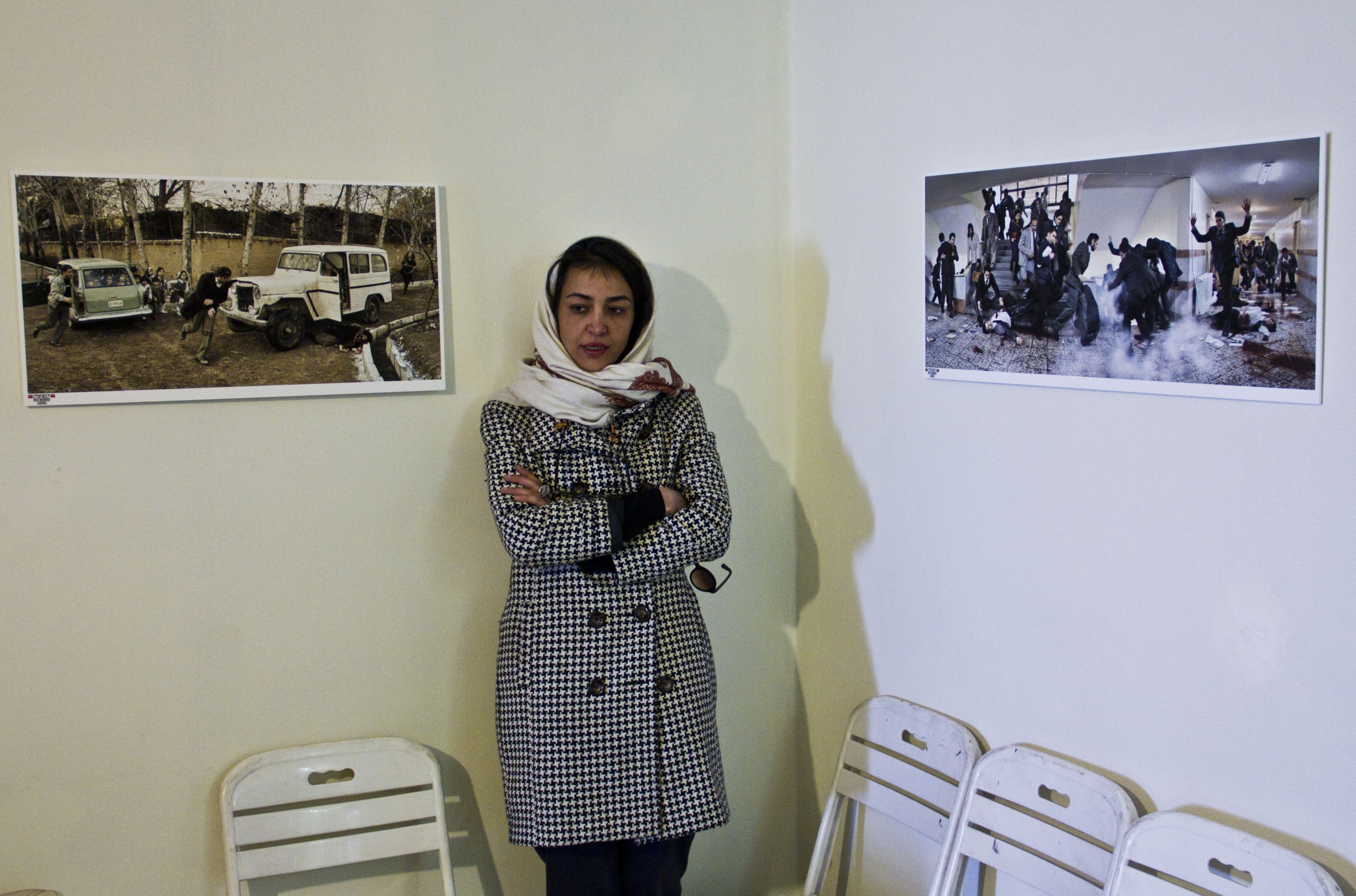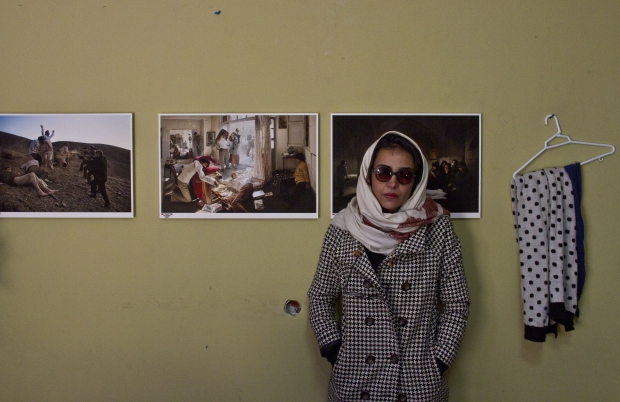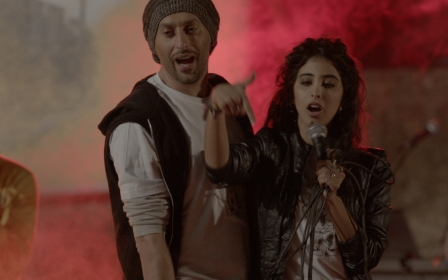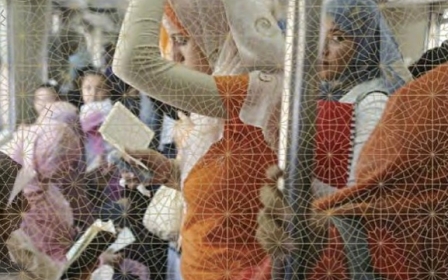BOOK REVIEW: Witness to the deaths of Iran’s forgotten heroes

A man with a bullet hole in his white shirt and a trail of blood coming out of his mouth lies crumpled on the floor. Books and papers are scattered around his fallen body. Two other young men lie in their own blood in the corridor, where a crowd flees the chaos and horror. Young students run down the stairs, some scream and others are shocked.
Is this historical record or fiction? Neither and both. The image is a re-enactment of real events taken by Iranian photographer Azadeh Akhalghi. It depicts the 7 December 1953 demonstration on the Tehran University campus that took place four months after the US- and UK-planned coup d’etat which toppled Iran’s democratically elected prime minister Mohammad Mossadegh.
The scene is recreated in a photography project and book, By An Eye Witness, in which Akhalghi restages the unmourned deaths of prominent figures from her motherland’s history over the last century or more.
The 1953 demonstration was held in opposition to Richard Nixon’s visit to his close ally, the King of Iran Mohammad Reza Shah Pahlavy. The result of this visit was the 68 bullets fired at Tehran University and the three students who were murdered. Two of them were communists and the third was a nationalist.
After the 1979 Revolution, Iranian officials commemorated this incident on Student Day. But for Akhlaghi, recreating the death scene was the proper way of remembering the bloodiest day in the history of Iran’s oldest modern university.
New MEE newsletter: Jerusalem Dispatch
Sign up to get the latest insights and analysis on Israel-Palestine, alongside Turkey Unpacked and other MEE newsletters
Witnessing Iran’s crucial deaths
By An Eye Witness is a book about death. The book depicts assassinations of leftists hunted down by the notorious intelligence service SAVAK, the torture of freedom fighters and journalists, deaths in custody, accidents and the fallen soldiers in the Iran–Iraq War.
"I kept asking myself why certain prominent figures who were killed or had mysterious deaths at critical moments of our modern history constantly came into sight and then vanished. It’s as if they are phantoms of our collective memory," Akhlaghi said, adding, "In this photography project I endeavoured to find an answer to this question."
The death of Iran’s first democratically elected Prime Minister Mohammad Mossadegh under house arrest in 1967, the slaying of the three Tehran University students in 1953, the suspicious suicide of Iran’s wrestling world champion Gholamreza Takhti in 1968, the dubious drowning of children’s book writer Samad Behrangi in 1967, and the air injection that murdered Mohammad Farrokhi Yazdi, an important political figure, journalist and poet in 1939, are a few examples of the incidents re-enacted by Akhlaghi for the By An Eye Witness project.
"Let’s take Farrokhi Yazdi as an example", she suggested. "During the 1979 Revolution, he reemerged in the collective memory of the Iranians. At the time, people republished his poems 40 years after his death, but then he was forgotten again. The same goes for Gholamreza Takhti and Samad Behrangi."
According to the photographer, well-known political, social and cultural figures come to the forefront when Iranians are in urgent need of "supernatural assistance to effect a change in their social and political situation".
"That’s when forgotten politicians and freedom fighters move out of the dusty closet of history and come back to life. After a while though, they return to their neglected corner until the next wave of change comes," she said.
Instead of history, Akhlaghi’s early artistic works were related to social and cultural dilemmas and later her focus turned to Iran’s modern history, political deaths and collective nostalgia. The 37-year-old photographer holds an MA in Computer Science from RMIT University in Melbourne, but she soon switched her focus and moved into the visual arts scene to express her social and political concerns. Between 2005 and 2008 she worked as an assistant director for internationally acclaimed Iranian filmmakers such as Abbas Kiarostami and Manijeh Hekmat before turning to her own photographic projects.
In her previous work, Me As Proffered By Others", she asked a cross-section of people to choose an outfit for her, and posed with them for a photo. After Iran’s 2009 election and the Arab uprising of 2010-11, politically related deaths became the focal point of her artistic creation. "In our modern history, thousands of people have died in an unending fight for a better life. But those who survived have rarely had the chance to mourn their slain loved ones," she noted.
"Some of the figures whose death scenes I recreated don’t even have a grave. How can a nation that has witnessed the death of its heroes turn the page and start a new chapter of collective memory without thoroughly mourning them?" Akhlaghi asked. "That’s why our 'always-mourning people' have held on to the grief and pain of those losses for a long time and still it is vividly present in society."
Akhlaghi is the first Iranian artist who through an art project openly presents a personal reading of her country’s modern history. Half of the prominent figures presented in By An Eye Witness, specifically the leftist ones, have no place in official narratives and books published in Iran.
However, Akhlaghi’s latest project, which has received positive reviews and considerable attention both in Iran and on the international art scene, lacks the meticulous reconstruction of certain scenes. One of these instances relates to the death of the Iranian journalist and revolutionary Mirza Jahangir Khan in the wake of the 1908 Russian-backed coup d’etat. In her recreation, the details of his death are mixed up with the detention of other revolutionaries who were arrested and chained in the Bagh-e Shah Garden on the same day, but on a different occasion and circumstance.
Revisiting a vicious cycle
After five years of focusing on death and nostalgia in Iran’s modern history, Akhlaghi is now "emotionally tired of dealing with death for such a long time". In a new project, the artist is digging deeper into her country’s history. This yet unnamed photography project is about the political turning points of the history of Iran between the 1906 Constitutional Revolution and the 1979 Revolution.
"With the new project, I am going to shine a light on a significant important era in Iran’s history," Akhlaghi said in her office, photo prints from By An Eye Witness" on the walls surrounding her.
"In that period, we overthrew three kings, and a substantial number of activists, politicians and common people were mercilessly murdered in each struggle. But after toppling one king, another one would come into power and the same old story was repeated. It’s like being trapped in a vicious cycle," she says, chain-smoking on regular Bahmans, a low-priced and widely popular cigarette among Iranian university students.
For the upcoming project she is recreating the crucial moments of Iran’s Constitutional Revolution, the oil nationalisation movement, the 1953 coup d’etat, the 15th of Khordad Uprising in 1963, and the Siahkal incident that marked the beginning of Iran’s leftist guerrilla movement, to name a few. In her opinion foreign interference in many of these incidents had a grave influence on the fate of Iran.
"I believe the Iranians have tried several times to escape this vicious cycle, but other factors have thwarted their attempts," explained Akhlaghi. "For instance, the CIA- and MI6-backed coup in 1953 dramatically changed the destiny of our nation. I think if Mossadegh could have stayed in power for a few more years, we would have the deep-rooted infrastructures of democracy."
Akhlaghi’s previous experience dealing with historical reconstruction taught her that past moments are not repeatable and that it is impossible to recreate all the details of such incidents. "I do my best to collect as much data as possible through interviews and research. Nevertheless, in the end it is I who reconstructs history according to my knowledge, mentality and viewpoint," she stressed.
After publishing By An Eye Witness with its photos, detailed explanations and historical facts on the dramatic deaths recreated therein, she hopes to reach the target audience of her new project. "I look for common people to come and view my work. My audience is not the elite art fans who every week visit the galleries in Tehran," she noted.
"Common people are not like the art fans, but they have deep concerns about their country and its history. They are my audience. I want to present my work to them like a traditional teahouse painting."
Middle East Eye delivers independent and unrivalled coverage and analysis of the Middle East, North Africa and beyond. To learn more about republishing this content and the associated fees, please fill out this form. More about MEE can be found here.





